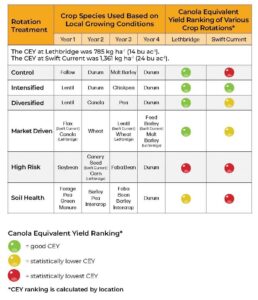The best crop rotation
…will depend on the region and the farm goals. A five-year study evaluated region-specific crop rotations for nitrogen fertilizer use efficiency, precipitation use efficiency, yield and net revenues.
In Kui Lui’s five-year ‘Optimizing systems productivity, resilience and sustainability in the major Canadian ecozones’ project, six region-specific crop rotations were evaluated for nitrogen fertilizer use efficiency, precipitation use efficiency, yield and net revenues at seven locations that spanned the Northern Prairies, Southern Prairies and the Red River Valley.
Results suggest that while no single cropping system is suitable for all of Western Canada, a rotation with more than two crop species, including pulse crops (which often increased the nutrient use efficiency), tended to be more favourable. Learn more in the “What is the best crop rotation for the Prairie provinces?” blog on the Canola Research Hub.
Key findings for each region
• Northern Prairies (Beaverlodge and Lacombe, AB and Scott and Melfort, SK sites): The “intensified rotation” (canola-wheat-canola-wheat) had the most stable yield, while the “market driven rotation” (which varied by province) and the “high risk rotation” (flax-soybean-durum-canola) had the least stable yields.
• Southern Prairies (Lethbridge, AB and Swift Current, SK sites): The “intensified rotation” and “diversified rotation” (lentil-durum-chickpea-durum) consistently had the highest nitrogen use efficiency in this region, which is likely attributed to pulse crops in two of
four years.
• Red River Valley (Carman, MB site): The “high risk rotation” (corn-dry bean-canola-sunflower) followed by the “market driven rotation” (corn-corn-oat-canola) had better precipitation use efficiency due to the high corn yields in these rotations.
Yield and yield stability by crop rotation in southern prairies, 2018-2021
Read all of the “Resilient Rotations” factsheets here.

Research camping
Thanks to all the farmers who took the time and effort to host MCGA Research campers (including me) at their farms, share about their operations and answer our questions! There was such a diversity in the farm operations and field environments between locations. Similar to researchers, each farmer was passionate about a unique priority or subject area (ex. soil health, equipment efficiency, cost of production) and had an impressive ability to problem solve and managed multiple concurrent activities.




